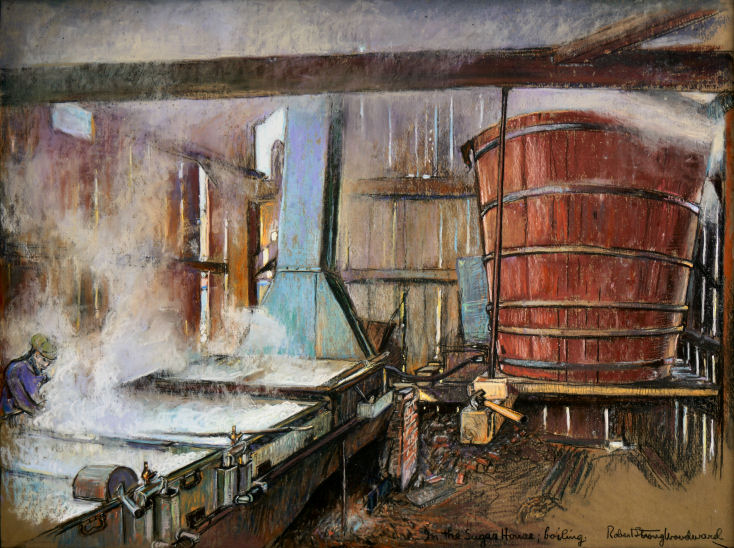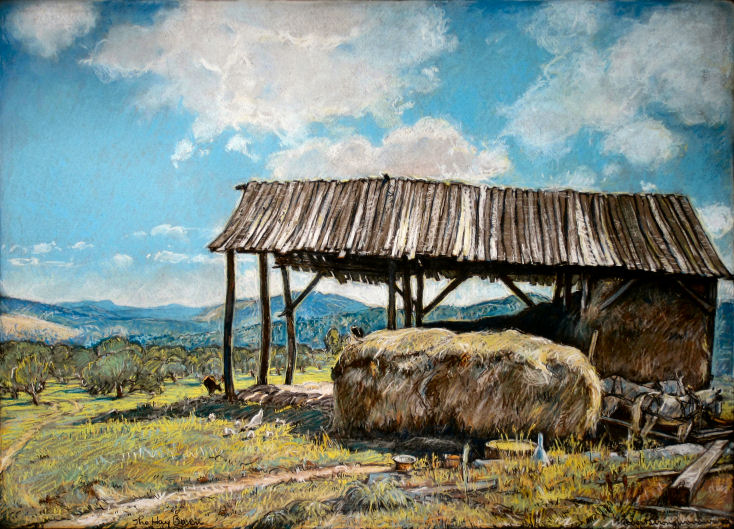Quick Reference
Unknown
Buckland, MA
Oil on Canvas
Landscape
Sugaring
27" x 30"
Unknown
Unknown
N/A
Featured Artwork: Sugaring
RSW's Diary Comments
There are no known diary comments regarding this painting.

 When Sap Runs, 1930-'31
When Sap Runs, 1930-'31
This is the closest known painting that fits the
description of a sugar bush. Note all the buckets
collecting sap. However, there is no shack visible
Editor's Note:
This is a very unusual painting for Woodward and this is the only picture we
have of it. It was taken from the auction program cited below. The scene appears to be a sugar
shack in the woods and if those woods are maples then technically the shack is "in the sugar
bush." One can just make out what appears to be buckets on the trees to the left of the picture.
On the right of the painting, seems to be a men on a cart of some sort and one can just make
out with looks like a horse harness. It is hard to tell.
This painting is unlike any other sugaring painting by Woodward which can easily be divided
into four catagories; (1) sugar house interiors, (2) the roadside sugar houses, (3) maples with
red sap buckets attached, or (4) men collecting sap. Only the painting
When Sap Runs (1930-'31) could be linked to this painting in terms of being a
wooded interior.
A painting by the name, In the Sugar Bush exhibited
at Woodward's alma matar, Bradley Polytechnic Institute, in Peoria, IL, in 1919. We have no
picture of In the Sugar Bush no more information on the painting. Still, it is possible
the two paintings are related based on Wikipedia's description of a "sugar bush:"
"A sugar bush is, a forest stand of maple trees which is utilized for maple syrup. This was originally an Indigenous camp set up for several weeks each spring, beginning when the ice began to melt and ending when the tree buds began to open. At a traditional sugarbush, all the trees were hand tapped and the sap was boiled over wood fires. The Anishinaabe (Ojibwe) peoples have been doing sugarbush for generations and consider the process both a part of food and of medicine." Wikipedia
Please take a moment to visit the Wikipedia page which has two works of art taken from the published 1903 New York (State), Forest, Fish and Game Commission Report portraying the sugar bush. ESPECIALLY the painting by Henry S. Watson titled "After Tapping". It is just wonderful. I wish it was in color. [Brian]
Additional Notes
 On July 10, 1993, a painting titled Sugaring. was sold
by Young Fine Arts Auctions, Inc. in North Berwick, Maine, from a private collection of New England
art and artists, formerly the High Voltage Engineering Collection for $3,250. We could not find any
more information other than to say the collection might have been related to MIT somehow.
On July 10, 1993, a painting titled Sugaring. was sold
by Young Fine Arts Auctions, Inc. in North Berwick, Maine, from a private collection of New England
art and artists, formerly the High Voltage Engineering Collection for $3,250. We could not find any
more information other than to say the collection might have been related to MIT somehow.



.png)

734.png)